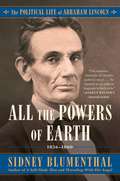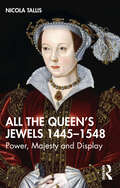- Table View
- List View
All the Lights Above Us: Inspired by the women of D-Day
by M. B. HenryAcross Europe, on what history will call D-Day, five unforgettable women from all walks of life strive to survive the most terrifying night of their lives. Told in alternating viewpoints, this unforgettable debut is perfect for fans of Kate Quinn and Pam Jenoff.June 6, 1944. Allied forces hit the beaches of Nazi-occupied France. Among the countless lives shattered are those of five spirited women with starkly different lives. As the war reaches its tipping point, each of the women fight for the survival of themselves, their countries, and their way of life during one of the most pivotal days in history. American expatriate Mildred, better known as Axis Sally, has a thriving career as a Nazi radio propagandist, but her conscience haunts her. Meanwhile, across the English Channel, young medical volunteer Theda is pushed to her limit as shiploads of casualties dock in Portsmouth. Closer to the front, intrepid Flora aids the French resistance, while she seeks out her vanished parents. Iron-willed Emilia has climbed the Gestapo ranks, but she is now bent on betraying them. Finally, dignified Adelaide&’s faith is shaken when she is forced to quarter German soldiers.Now, during the most perilous twenty-four hours of their lives, all five women must summon courage they never knew they had, as they confront the physical dangers of war, alongside treacherous family secrets, heartbreak, and the ability to trust themselves. For these women, their inner strength is their only hope. But is it enough? How far can one person go for the things they believe in?
All the Little Hopes: A Novel
by Leah WeissA Southern story of friendship forged by books and bees, when the timeless troubles of growing up meet the murky shadows of World War II.Deep in the tobacco land of North Carolina, nothing's been the same since the boys shipped off to war and worry took their place. Thirteen-year-old Lucy Brown is precocious and itching for adventure. Then Allie Bert Tucker wanders into town, an outcast with a puzzling past, and Lucy figures the two of them can solve any curious crime they find—just like her hero, Nancy Drew.Their chance comes when a man goes missing, a woman stops speaking, and an eccentric gives the girls a mystery to solve that takes them beyond the ordinary. Their quiet town, seasoned with honeybees and sweet tea, becomes home to a Nazi prisoner-of-war camp. More men go missing. And together, the girls embark on a journey to discover if we ever really know who the enemy is.Lush with Southern atmosphere, All The Little Hopes is the story of two girls growing up as war creeps closer, blurring the difference between what's right, what's wrong, and what we know to be true.
All the Lives We Never Lived: A Novel
by Anuradha RoyFrom the Man Booker Prize-nominated author of Sleeping on Jupiter and &“one of India&’s greatest living authors&” (O, The Oprah Magazine), a poignant and sweeping novel set in India during World War II and the present day about a son&’s quest to uncover the truth about his mother. In my childhood, I was known as the boy whose mother had run off with an Englishman. The man was in fact German, but in small‑town India in those days, all white foreigners were largely thought of as British. So begins the &“gracefully wrought&” (Kirkus Reviews) story of Myshkin and his mother, Gayatri, who rebels against tradition to follow her artist&’s instinct for freedom. Freedom of a different kind is in the air across India. The fight against British rule is reaching a critical turn. The Nazis have come to power in Germany. At this point of crisis, two strangers arrive in Gayatri&’s town, opening up to her the vision of other possible lives. What took Myshkin&’s mother from India and Dutch-held Bali in the 1930s, ripping a knife through his comfortingly familiar universe? Excavating the roots of the world in which he was abandoned, Myshkin comes to understand the connections between the anguish at home and a war‑torn universe overtaken by patriotism. Evocative and moving, &“this mesmerizing exploration of the darker consequences of freedom, love, and loyalty is an astonishing display of Roy&’s literary prowess&” (Publishers Weekly).
All the Lives We Never Lived: Shortlisted for the 2020 International DUBLIN Literary Award
by Anuradha Roy**NOW SHORTLISTED FOR THE 2020 INTERNATIONAL DUBLIN LITERARY AWARD**"A writer of great subtlety and intelligence . . . a beautifully written and compelling story of how families fall apart and what remains of the aftermath" Kamila Shamsie, winner of the Women's Prize for Fiction 2018 "The book everyone is talking about for the summer" Lorraine Candy, Sunday TimesIn my childhood, I was known as the boy whose mother had run off with an Englishman" - so begins the story of Myshkin and his mother, Gayatri, who is driven to rebel against tradition and follow her artist's instinct for freedom.Freedom of a different kind is in the air across India. The fight against British rule is reaching a critical turn. The Nazis have come to power in Germany. At this point of crisis, two strangers arrive in Gayatri's town, opening up for her the vision of other possible lives. What took Myshkin's mother from India to Dutch-held Bali in the 1930s, ripping a knife through his comfortingly familiar environment? Excavating the roots of the world in which he was abandoned, Myshkin comes to understand the connections between anguish at home and a war-torn universe overtaken by patriotism. Anuradha Roy's enthralling novel is a powerful parable for our times, telling the story of men and women trapped in a dangerous era uncannily similar to the present. Impassioned, elegiac, and gripping, it brims with the same genius that has brought Roy's earlier fiction international renown."One of India's greatest living authors" - O, The Oprah Magazine"Roy's writing is a joy" - Financial Times
All the Memorable Rounds: Golf Adventures and Misadventures, from Augusta National to Cypress Point and Beyond
by Tripp Bowden Bob Jones IvIn All the Memorable Rounds, author Tripp Bowden asserts that it is the experience that defines a golf course. This includes the experience from the parking lot to the pro shop, the golf course to the caddies, the first tee jitters to the eighteenth tee with all bets on the line. The experience is at the nineteenth hole, commiserating over a pint to the ones that got away, raising a glass to the ones that didn’t.Bowden includes his own stories from some of the most noteworthy courses in America, while weaving in testimonies from fellow golf lovers and professionals. From Augusta National to Cypress Point, and many in between, the reader can live, love, and learn alongside Bowden and friends. Featured experiences include: Playing a round at Palmetto Golf Club and discovering the never-before-told story behind course designer Alister MacKenzie. Learning about Ben Hogan’s private table in the grill room at Shady Oaks and learning the true secret to the Hogan swing. Reliving the game of golf for the first time again at a municipal golf course in Augusta, Georgia, called the Cabbage Patch, through the eyes of a nine-year-old first-time golfer.All the Memorable Rounds goes beyond the slope ratings and dives deep into the experiences that make the game of golf one of the oldest and most celebrated in the world.
All the Nations Under Heaven: Immigrants, Migrants, and the Making of New York, Revised Edition (Columbia History Of Urban Life Ser.)
by Robert SnyderFirst published in 1996, All the Nations Under Heaven has earned praise and a wide readership for its unparalleled chronicle of the role of immigrants and migrants in shaping the history and culture of New York City. This updated edition of a classic text brings the story of the immigrant experience in New York City up to the present with vital new material on the city’s revival as a global metropolis with deeply rooted racial and economic inequalities.All the Nations Under Heaven explores New York City’s history through the stories of people who moved there from countless places of origin and indelibly marked its hybrid popular culture, its contentious ethnic politics, and its relentlessly dynamic economy. From Dutch settlement to the extraordinary diversity of today’s immigrants, the book chronicles successive waves of Irish, German, Jewish, and Italian immigrants and African American and Puerto Rican migrants, showing how immigration changes immigrants and immigrants change the city. In a compelling narrative synthesis, All the Nations Under Heaven considers the ongoing tensions between inclusion and exclusion, the pursuit of justice and the reality of inequality, and the evolving significance of race and ethnicity. In an era when immigration, inequality, and globalization are bitterly debated, this revised edition is a timely portrait of New York City through the lenses of migration and immigration.
All the People (A History of Us #10)
by Joy HakimPeople call it "post-war," but All the People covers a period in U.S. history that features battles of another kind-- from Cold War combat overseas to struggles for equality at home to learning to live with the threat of terrorism on U.S. soil. During these years, the United States began to be a nation for all its people, outlawing school segregation, protesting war in Vietnam, and campaigning for equal rights for women. From Supreme Court Justice Thurgood Marshall to seamstress Rosa Parks, extraordinary individuals led us back to the ideals espoused by the Declaration of Independence, the Constitution, and the Bill of Rights. But mostly-- as it always has been in the United States-- it was ordinary citizens who marched and voted and hoped and dreamed and made things happen. All the People includes the events of September 11, 2001, and a discussion of how many aspects of the terrorist attacks have brought to the forefront the qualities that keep America strong: representative democracy, freedom of speech and press, and, especially in the face of religious totalitarianism, the basic freedom of religious tolerance. [This text is listed as an example that meets Common Core Standards in English language arts in grades 4-5 at http://www.corestandards.org.]
All the Pieces Matter: The Inside Story of The Wire®
by Jonathan Abrams<P>The definitive oral history of the iconic and beloved TV show The Wire, as told by the actors, writers, directors, and others involved in its creation. <P>Since its final episode aired in 2008, HBO's acclaimed crime drama The Wire has only become more popular and influential. The issues it tackled, from the failures of the drug war and criminal justice system to systemic bias in law enforcement and other social institutions, have become more urgent and central to the national conversation. <P>The show's actors, such as Idris Elba, Dominic West, and Michael B. Jordan, have gone on to become major stars. Its creators and writers, including David Simon and Richard Price, have developed dedicated cult followings of their own. Universities use the show to teach everything from film theory to criminal justice to sociology. Politicians and activists reference it when discussing policy. When critics compile lists of the Greatest TV Shows of All Time, The Wire routinely takes the top spot. It is arguably one of the great works of art America has produced in the 20th century. <P>But while there has been a great deal of critical analysis of the show and its themes, until now there has never been a definitive, behind-the-scenes take on how it came to be made. With unparalleled access to all the key actors and writers involved in its creation, Jonathan Abrams tells the astonishing, compelling, and complete account of The Wire, from its inception and creation through its end and powerful legacy. <P><b>A New York Times Bestseller</b>
All the Pleasures of the Season (Archer Family Novellas)
by Lecia CornwallOn the first day of Christmas:Lady Miranda Archer accepts a marriage proposal.On the first day of Christmas, fifteen minutes later:Miranda realizes she’s made a huge mistake.For the next twelve days:Miranda must find a way out of her engagement—which is harder than it looks, especially since her fiancé is pompous, mean, and desperate for her family’s jewels—and convince her true love that all she wants for Christmas is him.
All the Pope's Men: The Inside Story of How the Vatican Really Thinks
by John L. Allen Jr.A fascinating and enlightening look at the world's oldest and most mysterious institution, written by an American journalist with unparalleled knowledge about the Vatican's past and present. The sexual abuse scandals that shook American and British Catholicism in 2002 brought to light a long-standing cultural gap between the English-speaking Catholic world and the Vatican. In Rome, the crisis was often seen as an attack on the Church mounted by money-hungry lawyers, a hostile press, and liberal activists who used it as a way to turn attention on such concerns as celibacy, women's ordination, and lay empowerment. When the Vatican struck down the U. S. bishops' draft for handling allegations of sexual abuse, many saw it as an attempt to curb an independent American Catholic church. Yet, as time passed, it became clear that the Vatican's well-founded concerns about due process were shared by most liberal U. S. bishops and canon lawyers. ALL THE POPE'S MEN is a lucid, in-depth guide to the sometimes puzzling, often incomprehensible inner workings of the Vatican. It reveals how decisions are made, how papal bureaucrats think, and how careers in the Roman Curia are shaped. It debunks the myths that have fed the distrust and suspicions many English-speaking Catholics harbor about the way the Vatican conducts its business, explains who really wields the power, and offers entertaining profiles of the personalities, historical and present-day, who have wielded that power for good and for bad. A thoughtful analysis of the recent sexual abuse crisis sheds light on how the Vatican perceives the Church in the United States. Balanced, lively, and filled with Vatican history and lore, ALL THE POPE'S MEN provides the general reader with an authoritative picture of the highly charged relationship between the Vatican and the richest, most influential national Catholic church in the world today.
All the Powers of Earth: The Political Life of Abraham Lincoln Vol. III, 1856-1860 (The Political Life of Abraham Lincoln #3)
by Sidney BlumenthalIn All the Powers of Earth, Lincoln's incredible ascent to power in a world of chaos is newly revealed through the great biographer's extraordinary research and literary style. After a period of depression that he would ever find his way to greatness, Lincoln takes on the most powerful demagogue in the country, Stephen Douglas, in the debates for a senate seat. He sidelines the frontrunner William Seward, a former governor and senator for New York, to cinch the new Republican Party’s nomination. All the Powers of Earth is the political story of all time. Lincoln achieves the presidency by force of strategy, of political savvy and determination. This is Abraham Lincoln, who indisputably becomes the greatest president and moral leader in the nation’s history. But he must first build a new political party, brilliantly state the anti-slavery case and overcome shattering defeat to win the presidency. In the years of civil war to follow, he will show mightily that the nation was right to bet on him. He was its preserver, a politician of moral integrity. All the Powers of Earth cements Sidney Blumenthal as the definitive Lincoln biographer.
All the President's Men
by Bob Woodward Carl BernsteinIn the most devastating political detective story of the century, two Washington Post reporters, whose brilliant, Pulitzer Prize-winning investigation smashed the Watergate scandal wide open, tell the behind-the-scenes drama the way it really happened. <P><P> Beginning with the story of a simple burglary at Democratic headquarters and then continuing with headline after headline, Bernstein and Woodward kept the tale of conspiracy and the trail of dirty tricks coming -- delivering the stunning revelations and pieces in the Watergate puzzle that brought about Nixon's scandalous downfall. <P>Their explosive reports won a Pulitzer Prize for The Washington Post and toppled the President. This is the book that changed America.
All the President's Men (Bloomsbury Film Classics Ser.)
by Bob Woodward Carl Bernstein50th Anniversary Edition—With a new foreword on what Watergate means today. &“The work that brought down a presidency...perhaps the most influential piece of journalism in history&” (Time)—from the #1 New York Times bestselling authors of The Final Days. The most devastating political detective story of the century: two Washington Post reporters, whose brilliant, Pulitzer Prize-winning investigation smashed the Watergate scandal wide open, tell the behind-the-scenes drama the way it really happened. One of Time magazine&’s All-Time 100 Best Nonfiction Books, this is the book that changed America. Published just months before President Nixon&’s resignation, All the President&’s Men revealed the full scope of the scandal and introduced for the first time the mysterious &“Deep Throat.&” Beginning with the story of a simple burglary at Democratic headquarters and then continuing through headline after headline, Bernstein and Woodward deliver a riveting firsthand account of their reporting. Their explosive reports won a Pulitzer Prize for The Washington Post, toppled the president, and have since inspired generations of reporters. All the President&’s Men is a riveting detective story, capturing the exhilarating rush of the biggest presidential scandal in US history as it unfolded in real time.
All the Presidents' Bankers: The Hidden Alliances That Drive American Power
by Nomi PrinsWho rules America?All the Presidents' Bankers is a groundbreaking narrative of how an elite group of men transformed the American economy and government, dictated foreign and domestic policy, and shaped world history.Culled from original presidential archival documents, All the Presidents' Bankers delivers an explosive account of the hundred-year interdependence between the White House and Wall Street that transcends a simple analysis of money driving politics-or greed driving bankers.Prins ushers us into the intimate world of exclusive clubs, vacation spots, and Ivy League universities that binds presidents and financiers. She unravels the multi-generational blood, intermarriage, and protégé relationships that have confined national influence to a privileged cluster of people. These families and individuals recycle their power through elected office and private channels in Washington, DC.All the Presidents' Bankers sheds new light on pivotal historic events-such as why, after the Panic of 1907, America's dominant bankers convened to fashion the Federal Reserve System; how J. P. Morgan's ambitions motivated President Wilson during World War I; how Chase and National City Bank chairmen worked secretly with President Roosevelt to rescue capitalism during the Great Depression while J.P. Morgan Jr. invited Roosevelt's son yachting; and how American financiers collaborated with President Truman to construct the World Bank and IMF after World War II.Prins divulges how, through the Cold War and Vietnam era, presidents and bankers pushed America's superpower status and expansion abroad, while promoting broadly democratic values and social welfare at home. But from the 1970s, Wall Street's rush to secure Middle East oil profits altered the nature of political-financial alliances. Bankers' profit motive trumped heritage and allegiance to public service, while presidents lost control over the economy-as was dramatically evident in the financial crisis of 2008.This unprecedented history of American power illuminates how the same financiers retained their authoritative position through history, swaying presidents regardless of party affiliation. All the Presidents' Bankers explores the alarming global repercussions of a system lacking barriers between public office and private power. Prins leaves us with an ominous choice: either we break the alliances of the power elite, or they will break us.
All the Presidents' Children
by Doug WeadFrom Abigail "Nabby" Adams to Chelsea Clinton, George Washington Adams to John F. Kennedy, Jr., the children of America's presidents have both suffered and triumphed under the watchful eyes of their powerful fathers and the glare of the ever-changing public. Whether they perished under the pressure like Andrew Johnson, upheld controversial views like Amy Carter, or carried their father's torch right back to the White House like George W. Bush, all presidential children grew up having to share their fathers with the whole of their fellow countrymen -- and, in too many instances, spent the rest of their lives in a desperate search for their own identities. In this illuminating bestseller, Washington insider Doug Wead offers an authoritative analysis of our nation's presidential offspring. Featuring lively anecdotes, photographs, short biographies, and never-before-published personal accounts, All the Presidents' Children is an important socio-cultural work, a groundbreaking study of American family dynamics, and an entertaining foray into the homes, hearts, and history of our forefathers.
All the Presidents' Gardens: How the White House Grounds Have Grown with America
by Marta McDowellThis New York Times bestseller shares the rich history of the White House grounds, revealing how the story of the garden is also the story of America. The 18-acres surrounding the White House have been an unwitting witness to history—kings and queens have dined there, bills and treaties have been signed, and presidents have landed and retreated. Throughout it all, the grounds have remained not only beautiful, but also a powerful reflection of American trends. In All the Presidents' Gardens bestselling author Marta McDowell tells the untold history of the White House grounds with historical and contemporary photographs, vintage seeds catalogs, and rare glimpses into Presidential pastimes. History buffs will revel in the fascinating tidbits about Lincoln&’s goats, Ike's putting green, Jackie's iconic roses, Amy Carter's tree house, and Trump's controversial renovations. Gardeners will enjoy the information on the plants whose favor has come and gone over the years and the gardeners who have been responsible for it all. As one head gardener put it, &“What&’s great about the job is that our trees, our plants, our shrubs, know nothing about politics.&”
All the Presidents' Gardens: Madison's Cabbages to Kennedy's Roses—How the White House Grounds Have Grown with America
by Marta McDowellA New York Times Bestseller and AHS Book Award winnerThe 18-acres surrounding the White House have been an unwitting witness to history—kings and queens have dined there, bills and treaties have been signed, and presidents have landed and retreated. Throughout it all, the grounds have remained not only beautiful, but also a powerful reflection of American trends. In All the Presidents' Gardens bestselling author Marta McDowell tells the untold history of the White House Grounds with historical and contemporary photographs, vintage seeds catalogs, and rare glimpses into Presidential pastimes. History buffs will revel in the fascinating tidbits about Lincoln’s goats, Ike's putting green, Jackie's iconic roses, and Amy Carter's tree house. Gardeners will enjoy the information on the plants whose favor has come and gone over the years and the gardeners who have been responsible for it all.
All the Presidents' Money: How the Men Who Governed America Governed Their Money
by Megan GormanA journey through the personal money stories of the US presidents and how they built wealth—or didn&’t.Was Harry Truman really our poorest president or simply a man up at 2 a.m. struggling with financial anxiety? Did Calvin Coolidge get bad advice from his stockbroker to buy stocks in 1930 as the market continued to crash? Is it true George Washington enhanced his net worth by marrying up? We often think of the US presidents as being above the fray. But the truth is, the presidents are just like us—worried about money, trying to keep a budget, and chasing the American financial dream. While some presidents like Herbert Hoover and Gerald Ford became wildly successful with money, others like Thomas Jefferson and Joe Biden struggled to sustain their lifestyle. The ability to win the presidency is no guarantee of financial security, although today it&’s a much easier path to monetize. In All the Presidents&’ Money, tax attorney and wealth manager Megan Gorman takes us on a journey to understand the different personal money stories of the presidents. Grit, education, and risk are just some of the different ways that the presidents over the last 250 years have made (or lost) money. With lively storytelling and rigorous research, All the Presidents&’ Money reveals how some of the greatest leaders are the worst money managers and our least favorite presidents are good at making money.
All the Presidents' Pets: The Story of One Reporter Who Refused to Roll Over
by Mo RoccaAll the Presidents' Men meets Charlotte's Web in an explosive political exposé that blows the lid off a long-held secret in Washington: The Presidents' pets are more than just furry photo ops. How much does the public really know about the role of the President? Does the White House Press Corps really understand it? Does the President himself have a clue? All the Presidents' Pets is the long-awaited, spine-tingling, muckraking blockbuster from political and pop culture commentator Mo Rocca--a tour de force of investigative reporting that for the first time tells the true story of who really runs America. From George Washington's donkey, Royal Gift, and Rutherford B. Hayes's Siamese cat, Miss Pussy, to Lincoln's goats, Nanny and Nanko, and John Kennedy's Welsh terrier, Charlie, each has left an indelible mark on the White House. (In fact, Eisenhower's Weimaraner, Heidi, did leave a terrible stain on the Diplomatic Reception Room carpet. She was promptly exiled to Ike's Gettysburg farm.) InA ll the Presidents' Pets, Rocca lays bare the true stories of our nation's First Pets and sheds light on the origins and evolution of presidential power. Rocca plumbs rare sources, with the assistance of veteran White House correspondent Helen Thomas (the Stefanie Powers to his Robert Wagner), for the poop--er, scoop--on what really goes on in the West Wing. Once Helen reveals her deepest, darkest secret, the story turns dangerous. Filled with revelations and news breaks--and an unforgettable cast, including Wolf Blitzer, Ann Coulter, Sean Hannity, and a terrifying albino named Gephardt (no relation)--this is yet another story that the complacent Washington press corps missed. Forget Paul O'Neill. Richard Clarke? Who's that? All the Presidents' Pets is the groundbreaking political book that Bob Woodward could have written had he just spent a little less time with the President and a little more time with Barney. "Some will consider this satire. Mo Rocca describes how U.S. political policy has been guided by presidential pets for more than two hundred years. Oh, and I suppose you have a better explanation?" --P. J. O'Rourke. "All the Presidents' Pets is a deeply probing, thoroughly engaging account about how the media has uniformly overlooked the White House pet phenomenon to the detriment of our national memory. Thanks to Mo Rocca, no serious political commentator can properly analyze the Bush Administration without taking into consideration 'The Barney Factor.' And, for good measure, he has broken the story of Helen Thomas's lair, a cosmic revelation that will force historians to reinterpret presidencies dating as far back as James Garfield's tenure." --Douglas Brinkley, Professor of History and Director of the Eisenhower Center for American Studies, University of New Orleans. "A freaky, phantasmagoric trip through the secret history of presidential pets."--Robert Siegel, former editor in chief of The Onion.
All the Pretty Places: A Novel of the Gilded Age
by Joy Callaway&“A timeless and powerful novel of a daring woman who must decide if she will risk everything to follow her passion and find her voice.&” —Patti Callahan Henry, New York Times bestselling authorFrom the moment she was born, the transforming beauty of her family&’s nurseries has arrested her heart. From the moment she knew love, her heart belonged with his. Now she&’s at risk of losing them both.Rye, New York, 1893. Sadie Fremd&’s dreams hinge on her family&’s nursery, which has been the supplier of choice for respected landscape architects on the East Coast for decades. Now her small town is in a panic as the economy plummets into a depression, and Sadie&’s father is pressuring her to secure her future by marrying a wealthy man among her peerage—but Sadie has never been one to play it safe. Besides, her heart is already spoken for.Rather than seek potential suitors, Sadie pursues new business from her father&’s most reliable and wealthy clients of the Gilded Age in an attempt to bolster the floundering nursery. But the more time Sadie spends in the secluded gardens of the elite, the more she notices the hopelessness in the eyes of those outside the mansions. The poor, the grieving, the weary. The people with no access to the restorative beauty of nature.Sadie has always wanted her father to pass his business to her instead of to one of her brothers, but he seems oblivious to her desire and talent—and now to her passion for providing natural beauty to those who can&’t afford it. When former employee, Sam, shows up unexpectedly, Sadie wonders if their love can be rekindled or if his presence will simply be another reminder of a life she longs for and cannot have.Joy Callaway illuminates the life of her great-great-grandmother in this captivating story about a daring woman following her passion and finding her voice, while exploring natural beauty and its effect in the lives of those who need it most.Historical Gilded Age novel about an early American landscape nurseryStand-alone novelAlso by Joy Callaway: The Grand Design, The Fifth Avenue Artists Society, and Secret SistersIncludes discussion questions for book clubs
All the Queen's Players
by Jane FeatherAt Queen Elizabeth's palace, intrigue abounds. And when a naive girl with a gift for keen observation enters the court, she can hardly imagine the role she will play in bringing England indeed, the whole of Europe to the brink of war. Nor can she foresee her own journey to the brink of ecstasy and beyond. . . . When she becomes a junior lady of Queen Elizabeth's bedchamber, Rosamund is instructed by her cousin, the brilliant and devious secretary of state Sir Francis Walsingham, to record everything she observes. Her promised reward: a chance at a good marriage. But through her brother Thomas, Rosamund finds herself drawn to the forbidden, rough-and-tumble world of theatre, and to Thomas's friend, the dramatic, impetuous playwright Christopher Marlowe. And then Rosamund meets Will Creighton a persuasive courtier, poet, and would-be playwright who is the embodiment of an unsuitable match. The unsanctioned relationship between Rosamund and Will draws the wrath of Elizabeth, who prides herself on being the Virgin Queen. Rosamund is sent in disgrace to a remote castle that holds Elizabeth's cousin Mary Stuart, the imprisoned Queen of Scots. Here, Walsingham expects Rosamund to uncover proof of a plot against Elizabeth. But surely, nothing good can come of putting an artless girl in such close proximity to so many seductive players and deceptive games. Unless, of course, Rosamund can discover an affinity for passion and intrigue herself. . . . New York Times and USA Today bestselling author Jane Feather conspires with history to tell this dazzling story about two very real, very wily queens and one impassioned young woman whose life they change forever.
All the Queen's Spies: A Novel (An Agents of the Crown Novel #3)
by Oliver ClementsQueen Elizabeth I&’s advisor John Dee is in a race to save the Empire with the help of a mysterious manuscript offering global power in this continuation of the &“lively&” (The New York Times) Agents of the Crown series.With rumors of the end times swirling, philosopher and astronomer John Dee travels to Prague in an effort to prevent one of Catherine de Medici&’s seductive ladies-in-waiting from luring the Holy Roman Emperor into a crusade against England. To convince the famously occult-loving Emperor to join his side, Dee entices him with the esoteric Book of Secrets, a volume that, if decoded, could provide the chance to control the levers of heaven and earth. But Dee faces enemies at every turn, including a female codebreaker who could be the undoing of Dee and England itself.
All the Queen’s Jewels, 1445–1548: Power, Majesty and Display
by Nicola TallisFrom Margaret of Anjou to Katherine Parr, All the Queen’s Jewels examines the jewellery collections of the ten queen consorts of England between 1445–1548 and investigates the collections of jewels a queen had access to, as well as the varying contexts in which queens used and wore jewels. The jewellery worn by queens reflected both their gender and their status as the first lady of the realm. Jewels were more than decorative adornments; they were an explicit display of wealth, majesty and authority. They were often given to queens by those who wished to seek her favour or influence and were also associated with key moments in their lifecycle. These included courtship and marriage, successfully negotiating childbirth (and thus providing dynastic continuity), and their elevation to queenly status or coronation. This book explores the way that queens acquired jewels, whether via their predecessor, their own commission or through gift giving. It underscores that jewels were a vital tool that enabled queens to shape their identities as consort, and to fashion images of power that could be seen by their households, court and contemporaries. This book is perfect for anyone interested in medieval and Tudor history, queenship, jewellery and the history of material culture.
All the Rage: Power, Pain, Pleasure: Stories from the Frontline of Beauty 1860-1960
by Virginia NicholsonFrom the popular historian and author of Among the Bohemians and How Was It For You? comes a new offering, unbuttoning the multi-layered, hundred-year-history of women's lives through fashion and beauty from 1860 to 1960At the heart of this history is the female body.The century-span between the crinoline and the bikini witnessed more mutations in the ideal western woman's body shape than at any other period. In this richly detailed account, Virginia Nicholson, described as 'one of the great social historians of our time...' (Amanda Foreman) takes us to the Frontline of Beauty to reveal the power, the pain and the pleasure involved in adorning the female body.The PowerWho determines which shape is currently 'all the rage'? Looking at how custom, colour, class and sex fit into the picture, this book also charts how the advances made by feminism collided with the changing shape of desirability.The PainHere is Gladys, who had botched surgery on her nose; Dorothy, whose skin colour lost her an Oscar; Beccy who took slimming pills and died; and - unbelievably - the radioactive corset.The PleasureHere are the 'New Women' who discovered freedom by bobbing their hair; the boyish, athletic 'Health and Beauty' ladies in black knickers; and starlets in bohemian beachwear. Among the first to experience true women's liberation were the early adopters of trousers.Encompassing two world wars and a revolution in women's rights, All the Rage tells the story of western female beauty from 1860 to 1960, chronicling its codes, its contradictions, its lies, its highs - and its underlying power struggle.
All the Rage: Power, Pain, Pleasure: Stories from the Frontline of Beauty 1860-1960
by Virginia NicholsonFrom the popular historian and author of Among the Bohemians and How Was It For You? comes a new offering, unbuttoning the multi-layered, hundred-year-history of women's lives through fashion and beauty from 1860 to 1960At the heart of this history is the female body.The century-span between the crinoline and the bikini witnessed more mutations in the ideal western woman's body shape than at any other period. In this richly detailed account, Virginia Nicholson, described as 'one of the great social historians of our time...' (Amanda Foreman) takes us to the Frontline of Beauty to reveal the power, the pain and the pleasure involved in adorning the female body.The PowerWho determines which shape is currently 'all the rage'? Looking at how custom, colour, class and sex fit into the picture, this book also charts how the advances made by feminism collided with the changing shape of desirability.The PainHere is Gladys, who had botched surgery on her nose; Dorothy, whose skin colour lost her an Oscar; Beccy who took slimming pills and died; and - unbelievably - the radioactive corset.The PleasureHere are the 'New Women' who discovered freedom by bobbing their hair; the boyish, athletic 'Health and Beauty' ladies in black knickers; and starlets in bohemian beachwear. Among the first to experience true women's liberation were the early adopters of trousers.Encompassing two world wars and a revolution in women's rights, All the Rage tells the story of western female beauty from 1860 to 1960, chronicling its codes, its contradictions, its lies, its highs - and its underlying power struggle.
























